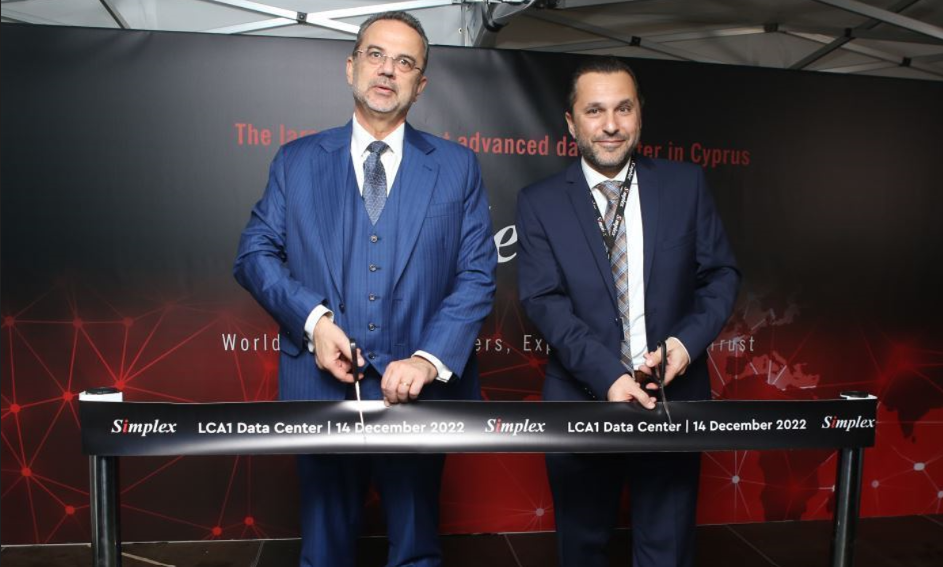Insights into Data Centre Investment & Market Growth
Data Centre Operations: Optimising Infrastructure for Performance and Reliability
Insights into Data Centre Investment & Market Growth
News in Cloud Computing & Data Storage
Sky’s the limit for cloud tech developer
Forrit will expand its operation after receiving scale up support from the Scottish National Investment Bank.
The £5 million of funding will allow the Edinburgh-headquartered technology developer to expand its workforce and target new markets.
The bank’s backing will see the creation of 15 new skilled jobs that will support Forrit’s expansion. The company will also strengthen its relationship with Microsoft as a ‘Preferred Solution’ and Microsoft Partner.
Forrit CEO, Peter Proud, says, “We’ve experienced enormous growth as a company since we launched almost a decade ago - building a brilliant team who have in turn created an extremely strong product. While to date we have self-funded our growth through client engagements, as we take Forrit to the next level, now felt like the right time for us to seek external institutional funding. This investment from the Scottish National Investment Bank will help us to expand our presence, not only in Scotland, but also to expand into new markets across the UK and beyond.
“We are incredibly proud of our Scottish roots, so working with another Scottish organisation was extremely important as both parties are focused on benefitting Scotland. We have ambitious plans and only want to add to the success of the Scottish tech ecosystem. We hope to continue to add to this both as a provider of an exemplary content management system, but also as an employer. Thanks to the bank’s investment, we look forward to growing that even further as we scale up both the company and our product.”
The Forrit investment will help further develop the Scottish tech ecosystem and enhance the sector’s global reputation.
Jimmy Williamson, Executive Director of innovation at the Scottish National Investment Bank says, “The bank’s investment will support Forrit as they look to reach the next stage of their development. Our investment will enable Forrit to create new, high value technology development jobs, futureproofing skills in Scotland’s tech ecosystem and supporting plans to export their differentiated proposition to enterprise clients globally.
“Forrit’s CMS system technology has a strong alignment with our Innovation mission and we look forward to working with them to deliver their ambitious growth plans.”
Beatrice - 13 April 2023
Hyperscale Data Centres: Scale, Speed & Strategy
Insights into Data Centre Investment & Market Growth
News
AirTrunk links its $5bn financing platforms to ESG
AirTrunk has linked 100% of its debt funding platforms to sustainability commitments following the raising of a $650 million Sustainability Linked Loan (SLL) in Japan. Across its financing platforms, AirTrunk has raised $5 billion in Environmental, Social and Governance (ESG) financing, making the company one of the largest issuers of sustainable financing in the data centre industry globally.
The incremental Japan SLL will finance a major expansion of AirTrunk TOK1 (TOK1) and is the first SLL for a data centre in Japan, and the first in APJ to combine operating energy and water efficiency as Key Performance Indicators (KPIs).
Energy and water are critical and interdependent resources that impact a data centre’s environmental footprint. As part of its commitment to accountability and transparency, AirTrunk continues to focus its financing KPIs on actual energy usage through operating power usage effectiveness (PUE) as opposed to design PUE.
AirTrunk plans to invest any margin incentives from the Japan SLL into social impact initiatives within Japan. Plans are underway to expand the program across APJ to support long term initiatives aligned to AirTrunk’s purpose of scaling and sustaining the region’s digital future. This will include supporting initiatives across four focus areas: equal digital access, STEM education, biodiversity and conservation, and innovation and research and development.
AirTrunk Chief Financial Officer, Prashant Murthy says, “By driving innovation in sustainable financing and creating a lasting impact in our communities, we are committed to powering positive industry change. We have now linked all our debt platforms to sustainability commitments, more than doubling our sustainable financing since our inaugural SLL launched in 2021. Our sustainable finance platform complements our recent commitment to net zero emissions by 2030.”
Beatrice - 14 March 2023
Data Centre Infrastructure News & Trends
Data Centres
Insights into Data Centre Investment & Market Growth
MDC boosts technology capabilities with significant investment
MDC Data Centres is pleased to announce a $3.4 million investment in upgrading its data centre infrastructure. During the past year, the company has purchased state-of-the-art equipment from Bud Griffin & Associates to upgrade its MCA2 data centre.
This investment will enable MDC to offer improved quality of service to its clients, as well as stay up to date on the latest technologies and best practices in the industry. The partnership with BGA will provide MDC Data Centres with access to its expertise and resources, further enhancing the company's commitment to providing top-notch data centre services to its customers.
"At MDC, our clients' satisfaction and long-term relationships are our top priorities. We believe that investing in our infrastructure with top providers such as BGA is an investment for the success of our clients. This upgrade to our MCA2 data centre will provide improved quality of service to our customers and minimise the risk of downtime, ensuring that we continue to be a trusted partner for businesses," says Ivan Eng, Strategic Planning Director at MDC.
BGA recognises that in today's world there are no ‘typical’ network applications. Every company's network is critical. BGA not only has the solutions, but also the knowledge and experience to support these application needs. Whether it is a large data centre or a remote site that requires single phase power and monitoring, BGA offers the technology and support to surpass its customers' needs.
Beatrice - 2 March 2023
Data Centres
Hyperscale Data Centres: Scale, Speed & Strategy
Insights into Data Centre Investment & Market Growth
Increasing data centre power consumption in an energy crisis
Paul Brickman, Commercial Director, for Crestchic Loadbanks, explores the often-overlooked necessity of loadbank testing in securing data centre power in an energy crisis.
Hiked power prices as a result of Russia’s fuel sanctions, and the threat of planned blackouts or power rationing to better manage an unstable grid, are forcing data centres to redistribute investment away from key business functions like training and recruitment, and towards improving energy efficiency and securing power resilience.
The current geopolitical challenges and their far-reaching implications are recognised in the 2023 Uptime Institute report, Five Data Centre Predictions for 2023, in which the authors acknowledge that the Russian fuel sanctions, along with technological challenges 'will make the planning of data centre development and operations more difficult.'
Powering next-generation data centres
According to the Uptime Institute, IT hardware has been fairly standard in terms of its draw on mainstream server capacity for a few decades now, creating technical stability and relatively constant power and cooling requirement.
This has enabled data centre designers to accommodate several IT refreshes without major upgrades to server technology and the associated hike in power consumption that would come with it. Essentially, offering the latest technologies, without an increase in energy requirement.
This grace period is now over. Power requirements for next-generation IT hardware are far higher, rack power density is increasing, and 'hotter' processors are putting pressure on the performance parameters of existing infrastructure.
This rapid rise in IT power density means server power consumption is on a steep climb, creating a need for more power, at a time when the grid is unstable, and energy prices are at their highest in decades.
Extreme-density racks are now commonplace in technical computing too, as well as high-performance analytics and artificial intelligence training. If data centre operators want to successfully penetrate these niche markets, they will need to foot the heightened energy bill and maintain a robust power resilience regime until the situation stabilises.
Data centres take action
The demand for next-generation IT technologies will not slow. As a result, data centres are forging ahead with the essential upgrades required to UPS, batteries, switchgear and generators to accommodate increased power density.
This is a risk. With an unstable grid and planned blackouts still on the agenda for many governments, upgrades will need to be bolstered with a watertight energy resilience plan to protect against power fluctuations and total outages.
The importance of a power resilience strategy in an energy crisis
According to research from the Ponemon Institute, in its third Cost of Data Centre Outages report, the total cost of downtime has continued to rise over the last six years - rising a staggering 38% to $740,357 per incident. That equates to nearly $9,000 per minute - a figure that many data centres will have to swallow if the grid becomes too unstable to sustain their increasing power consumption.
Many data centres will already have a robust generator testing and maintenance regime in place, but the use of loadbanks is often overlooked, especially when budgets are stretched. At a time when power outages are more likely, loadbank testing should play an integral role in a data centre’s energy resilience strategy and it would be prudent to evaluate your strategy in line with the current landscape to ensure it is robust enough. With this in mind, what would be considered best practice for testing a backup power system?
Best practice loadbank testing in times of crisis
Ideally, as a minimum, all generators should be tested annually for real-world emergency conditions by using a resistive-reactive 0.8pf loadbank. Best practice dictates that all gensets (where there are multiple) should be run in a synchronised state, ideally for eight hours but for a minimum of three.
Where a resistive-only loadbank is used, testing should be increased to two to four times per year at three hours per test. In carrying out this testing and maintenance, fuel, exhaust and cooling systems are effectively tested and system issues can be uncovered in a safe, controlled manner without the cost of major failure or unplanned downtime. The alternator is not thoroughly tested though, with a resistive-only test and therefore a resistive-reactive test would always be recommended.
It may be advisable to test more frequently during times of crisis for added peace of mind.
Why is resistive-reactive the best approach?
Capable of testing both resistive and reactive loads, this type of loadbank provides a much clearer picture of how well an entire system will withstand changes in load patterns while experiencing the level of power that would typically be encountered under real operational conditions.
Furthermore, the inductive loads used in resistive/reactive testing will show how a system will cope with a voltage drop in its regulator. This is particularly important in any application which requires generators to be operated in parallel (prevalent in larger business infrastructures such as hyperscale data centres) where a problem with one generator could prevent other system generators from working properly or even failing to operate entirely. This is something which is simply not achievable with resistive-only testing.
Navigating growth when power is scarce
No matter the geopolitical challenges and the effect it is having on power availability, data centres have no choice but to grow.
Demand will not cease, and power-intensive next-generation technologies are unavoidable. Ensuring power resilience via a watertight backup power supply and a robust testing and maintenance regime will enable data centre designers and operators to grow, safe in the knowledge that, should planned blackouts, power rationing or grid fluctuations happen, the power will always remain on.
Beatrice - 24 February 2023
Insights into Data Centre Investment & Market Growth
News
Infinidat names Steve Sullivan as Chief Revenue Officer
Infinidat has announced the promotion of Steve Sullivan to Chief Revenue Officer (CRO). Steve previously held the position of Executive Vice President and General Manager, Americas, where he demonstrated his leadership skills and sales acumen.
As Chief Revenue Officer, Steve will be responsible for overseeing all revenue-generating activities within Infinidat, including sales, go-to-market strategy, and customer success on a global scale. He will provide dynamic leadership for high-performance teams that are data-driven, insights-oriented, and proactive with customers and channel partners. The alignment of revenue functions under one senior executive will support the company’s growth initiatives.
“We are pleased to promote a proven, highly successful, and trusted executive leader to a position crucial to Infinidat’s continued growth and success,” says Phil Bullinger, CEO at Infinidat. “Steve brings to the CRO role a track record of building and leading high-performing teams that have set a very high standard for customer success and delivering technical and business value in enterprise storage. His leadership in the expanded CRO role will accelerate our growth as we scale our global account and partner relationships through collaborative and cohesive go-to-market strategies and programs.”
“I am honored to be promoted to Chief Revenue Officer and look forward to continuing to work with our talented teams across the globe to drive revenue growth and expand our market share,” says Steve. “We have such a highly differentiated value proposition for our customers, and we continually rank highest in customer success, two key components for continued growth. We will always continue to extend our investments in the total customer experience, ranging from solution architecting in collaboration with our channel partners to our white glove service and support that has earned the loyalty of global enterprises around the world.”
Steve brings over 25 years of executive sales experience in the storage industry to the role. Prior to joining Infinidat, Steve held senior leadership positions in various companies, where he developed a strong track record of revenue growth and customer acquisition. He has a B.S. in Finance from Boston College and an MBA from the Babson F.W. Olin Graduate School of Business.
Beatrice - 24 February 2023
Data Centres
Insights into Data Centre Investment & Market Growth
Vertiv introduces new prefabricated modular data centre solution
Vertiv has introduced the Vertiv MegaMod and Vertiv MegaMod Plus, a turnkey prefabricated modular (PFM) data centre solution, deployable in expandable units of 0.5 or 1MW for IT loads up to 2MW or more. The prefabricated modules are integrated and tested with Vertiv power management systems, thermal management solutions, remote monitoring and IT equipment racks to deliver performance, and help companies reduce deployment time by up to 40% when compared to a traditional data centre build.
Companies are racing to deploy processing power in new locations to meet demand for digital business products and services. The MegaMod, and the MegaMod Plus - which offers up to 25% more rack and cooling capacity - enable customers to expand core-to-edge data centre networks and rapidly deploy new compute capacity with lower upfront costs, greater predictability and less risk than traditional data centre builds, thanks to proven industrial processes and high standards of quality control. Both solutions provide options to grow horizontally or vertically, with MegaMod providing cooling capacity in the IT Hall area, while MegaMod Plus is configured with cooling modules that support the IT hall space expansions.
“Historically, facilities have typically been stick-built, requiring long lead times and heavy upfront capital investment. However, growing digitalisation trends have urged investors and data centre operators to reconsider this approach,” says Viktor Petik, Vice President and EMEA leader for Vertiv’s Integrated Modular Solutions business. “As demand for digital services soars, data centre owners are better able to capture this growth if they can accelerate the rollout of new capacity. The good news is that prefabricated modular data centres like Vertiv MegaMod enable stakeholders to act quickly.”
Vertiv says that the solution is ideal for medium size data centres, and can be easily deployed and expanded as business needs grow. Vertiv also provides end-to-end services for a straightforward start-up and smooth operation, including deployment, commissioning, ongoing maintenance, remote monitoring and training.
Beatrice - 7 February 2023
Commercial Real Estate: Property Developments, Trends & Infrastructure
Data Centres
Hyperscale Data Centres: Scale, Speed & Strategy
Insights into Data Centre Investment & Market Growth
News
DCI Data Centres appoints group CEO
DCI Data Centres (DCI) has announced the appointment of Nicholas Toh as the group Chief Executive Officer.
Nicholas is an industry veteran with more than 20 years’ experience across data centres, finance and real estate investments. He joins DCI from STT Global Data Centres, where he was one of the key founding team members, having been instrumental in the growth and development of the business, most recently as CEO, North-East Asia. During his time with STT GDC, he led market entry into the mature markets of UK and Japan as well as strategic investments and partnerships into India, South Korea, Indonesia, and the Philippines. Prior to joining STT, he was Senior Vice President at Securus Data Property Fund. An Australian national, Nicholas has also worked for Macquarie Group within the Banking and Financial Services group, as well as within Macquarie’s Real Estate group.
DCI Chair and Brookfield Global CEO Data Centres, Udhay Mathialagan says Nicholas brings an impressive track record in building data centre businesses across multiple geographies, marking a strategic milestone as DCI enters an accelerated growth phase.
“Nicholas’s appointment strengthens DCI’s growth trajectory as we look to build on our rapid growth in Australia and New Zealand by deepening our geographic and product strength in these markets in addition to targeted expansion across Asia. I am delighted to welcome Nicholas to the team,” adds Udhay.
“DCI’s growth and commitment to scale makes it an exciting time to join the company. DCI’s customer centric approach and ability to provide innovative solutions has enabled them to be a trusted partner, and I look forward to continuing to build the business and usher in new successes for our hyperscale customers,” Nicholas says.
Beatrice - 6 February 2023
Insights into Data Centre Investment & Market Growth
News
93 new hires drives global growth for MEP design firm
A global MEP engineering design company is continuing to grow rapidly as its global workforce expands. In the last 12 months, UK-headquartered Black and White Engineering (B&W) has become a 380 strong global team, a 34% increase in employees since the end of 2021. UK and Europe headcount has increased by nearly a third (32%) and the firm now employs a UK team of 100, with offices in Newcastle, Edinburgh and London - as well as multiple locations globally.
B&W is currently a £30 million revenue business due to its expanding client base and is now focused on strengthening its team of engineering design experts by recruiting up to 100 more specialists over the next 12 months. The company delivers innovative sustainable MEP design services across a number of industries, with a particular specialism in data centre MEP design.
Current global projects include a number of data centre developments across the UK and Europe, Middle East and APAC as well as high rise projects in the Middle East and buildings projects in the UK.
Rachel Ovington, Global HR Director at B&W, says, “Our people are fundamental to our growth, and we’ve been working hard on developing our HR strategy - which is focused on attracting and retaining talent, and developing careers through learning and employee wellbeing. We’ve worked tirelessly to develop a strong people-led strategy which is centred around our ‘one global team’ approach.
“Since I joined B&W my priority has been to establish our global approach to employee engagement, develop great talent and establish a stronger employer brand. We prioritise developing specialists through maintaining individuals’ focus on specific sectors, while also encouraging employee mobility with access to projects across the global business which exposes them to a broad spectrum of clients, environments and experience. We also have a passion for graduate recruitment and developing the next generation of engineering leaders, which is critical to our future as we grow our dynamic and talented global team.”
Working with specialist talent partner and recruitment specialists, Talentheads, B&W is looking to recruit across a number of roles including senior and principal engineers, BIM coordinators and managers, design engineers, power systems engineers, and document controllers. The firm has created opportunities from entry and graduate level employees, through to senior leadership roles. Investment in young people across different regions is prioritised with B&W supporting government and industry initiatives to attract more emerging talent to the MEP design sector, playing a key role in developing future generations of global MEP engineers.
Mick Cairns, CEO at B&W, says, “Our people-driven strategy is the catalyst for the exciting growth trajectory we’re on. Focusing on employee development, mentor programmes and establishing stronger wellbeing strategies is paying off and we are committed to improving further. Our business model focuses on developing our specialist team through maintaining individuals’ focus on specific sectors. We encourage employee mobility and exposure to projects across the global business which enhances the knowledge and expertise of our team and gives us a strong advantage in serving our clients around the globe.
“Because of this, we are now proudly positioned as a global leading MEP design company. Our excellence in data centres and highly sustainable and resilient building designs have enabled us to become the ‘go-to’ specialist consultancy with over 380 employees in eight locations globally which means our teams can tap into expertise from any location, at any time, offering a 24/7 client service.
“At B&W, knowledge management and mentoring are key, and we spend a considerable amount of time with employees at all levels to ensure our culture and passion for excellence runs through every team member.”
Beatrice - 6 February 2023
Data Centres
Insights into Data Centre Investment & Market Growth
Cumulus completes milestone in its flagship data centre campus build
Cumulus Data has announced that it has completed key milestones in the construction of phase one of its flagship 475MW zero carbon Susquehanna data centre campus located in northeast Pennsylvania. The construction of the powered shell for its first 48MW, 300,000ft² data centre is complete and available for lease, with various fibre routes in service.
The 1,200-acre campus, will provide zero carbon, low cost, reliable energy generated by Talen Energy’s Susquehanna nuclear power generation facility. The Cumulus data centres will be directly connected to the 2.5GW Susquehanna power stations, without intermediation by legacy electric transmission and distribution utilities, providing data centre customers with significant value and competitive advantages.
This direct-connect, on-site power generation model enables industry-leading total cost of ownership with the most attractive power rate in the US, according to Cumulus. The size and design of the Cumulus campus offers scalability, flexibility, and time-to-market advantages with build-to-suit options, coupled with zero carbon ESG customer benefits.
“Our flagship Cumulus Susquehanna data centre campus is positioned to welcome its first tenant and commence commercial operations this year,” says CEO Alejandro Hernandez. “We look forward to advancing our mission to solve the energy ‘trilemma’ which we define as the rapidly increasing consumer demand for zero carbon, low-cost, and reliable electricity by data centre customers, beginning with our first Cumulus Susquehanna data centre campus.”
Scott Hanna, Cumulus Chief Revenue Officer, adds, “There are currently few options that fulfil all three requirements at once - at massive scale, while offering data centre customers an industry leading TCO. As a member of the iMasons Climate Accord, Talen and Cumulus will support our customers in achieving carbon neutrality by uniting together to adopt a common standard enabled by solutions such as the Cumulus carbon free data centre platform.”
In addition to meeting the growing need for zero carbon, low cost, reliable energy to power technology applications, the Cumulus Susquehanna data centre campus investment will create jobs, provide technology training, and offer economic benefits including tax revenue and increased consumption of local goods and services to both Pennsylvania and the surrounding community.
Beatrice - 17 January 2023
Data Centres
Hyperscale Data Centres: Scale, Speed & Strategy
Insights into Data Centre Investment & Market Growth
Grand opening of Simplex LCA1 - the largest data centre in Cyprus
Simplex puts Cyprus on the global data centre map with a world-class facility - one of the most advanced in the region.
In a ceremony in the presence of Kyriakos Kokkinos, Deputy Minister of Research, Innovation and Digital Policy, the opening of Simplex LCA1 took place in Larnaca, Cyprus on 14 December 2022. More than 100 guests including government officials, businessmen, IT managers and other industry professionals, representing the business and political community of Cyprus, gathered to celebrate what is expected to be a milestone for Cyprus’ digital transition and a true diversifier for the country’s economy.
LCA1 is the largest data centre in Cyprus and one of the most advanced in the region, offering reliability, security and flexibility. Simplex is now the only neutral operator with two privately owned data centres at diverse locations.
LCA1 has been operating since December 2020, however, due to the pandemic Simplex never had the opportunity to celebrate its opening and decided to do so on its second birthday/anniversary. A testament for LCA1’s qualities is the international recognition it has received during these two years. In particular, it has been awarded for Reliable and Efficient Data Centre Operation at the Impact Bite Awards, while it has also been shortlisted as a finalist for the 2021 Middle East & Africa Data Centre Development Award of the DCD Awards.
The growing business community of Larnaca, sufficient distance from both Limassol (business and financial centre) and Nicosia (the capital) for disaster recovery purposes, and the convenience for international clients flying in through Larnaca International Airport, were reasons for choosing Larnaca to host this facility.
Designed and constructed with efficiency and sustainability at its core, LCA1 has adopted many green technologies and it will soon be using extensively, if not exclusively, green power from renewable sources, mainly solar. During the event, the company’s Director, Michael Omerou, announced the certification of the company’s Environmental Management System to ISO 14001, as well as the upcoming certification to EMAS, EU’s Eco-Management and Audit Scheme, becoming the first Cyprus data centre operator to receive such certifications.
Michael says, “I am really proud and excited to be standing in front of such a mass gathering that inevitably demonstrates the importance of data centres in general and LCA1 in particular. Neutral, multi-tenant data centres like LCA1 consist of important, critical infrastructure and generate a huge economic potential.
“Strategically located, literally at the crossroads of Europe, Asia, Africa and the Middle East, LCA1 is a truly enterprise, world-class data centre, that will serve not only domestic clients, but also regional and even international ones. Jointly with other technology companies of the island and of course, the government, we aim to establish an ecosystem that will attract international technology giants including content providers, international ISPs, cloud providers and other hyperscalers that through Cyprus will be able to serve neighbouring countries which suffer from political and financial fragility and, despite their big population/market size, do not offer reliable telecoms and electricity infrastructure. LCA1 will evolve as an investment magnet and a multiplier of economic growth for Cyprus’ economy.”
Beatrice - 17 January 2023

Head office & Accounts:
Suite 14, 6-8 Revenge Road, Lordswood
Kent ME5 8UD
T: +44 (0)1634 673163
F: +44 (0)1634 673173









